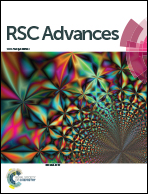Invariom approach as a new tool in electron density studies of ionic liquids: a model case of 1-butyl-2,3-dimethylimidazolium chloride BDMIM[Cl]†
Abstract
Modeling of the experimental electron density in an ionic liquid (IL), 1-butyl-2,3-methylimidazolium chloride, within the invariom approximation as compared to the multipole refinement of high-resolution X-ray diffraction data and periodic quantum chemical calculations shows the applicability of this approach for describing supramolecular organization in ILs. Although the invariom approximation explicitly ignores charge transfer occurring between the ions, it nevertheless reproduces the features of the H-bonds and much weaker interactions (stacking, C–H⋯π and H⋯H) at the same level or better than the conventional multipole refinement does. The invariom approximation thus makes experimental electron density studies of ILs, which are now scarce, a useful tool in searching for ‘structure–property’ relationships, as it entangles the complex interplay of interionic interactions that operate in ILs.
![Graphical abstract: Invariom approach as a new tool in electron density studies of ionic liquids: a model case of 1-butyl-2,3-dimethylimidazolium chloride BDMIM[Cl]](/en/Image/Get?imageInfo.ImageType=GA&imageInfo.ImageIdentifier.ManuscriptID=C5RA13752G&imageInfo.ImageIdentifier.Year=2015)

 Please wait while we load your content...
Please wait while we load your content...